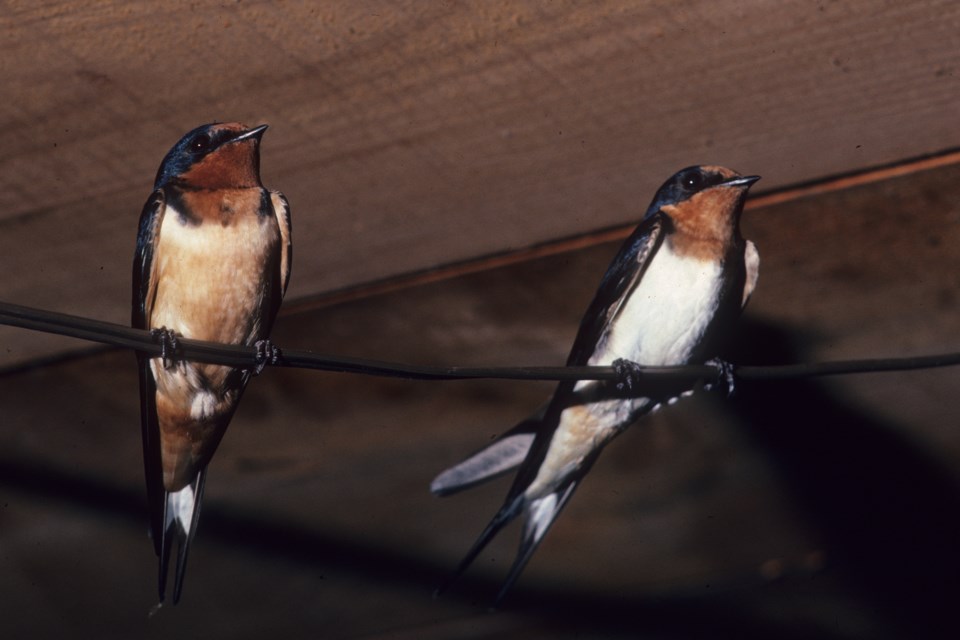It seems that some farmers will do anything to best their neighbour. Oh sure, fall fairs are the prime competing grounds, but what to do in spring and summer? Thanks to a recent bird study, some of the agriculturalists around Guelph have come up with a new slant on “my farm is better than your farm.”
It started with a study of barn swallows, those magnificent fork-tailed aerial masters. Anyone over the age of 50 and with even a smidge of farm background can attest to the large flocks of these birds that once upon a time lined the telephone wires. It seemed that every barn had at least a dozen nests, their mud-daubed structures glued precariously to the beams and rafters high overhead.
Alas, barn swallow populations are declining: steadily and alarmingly. Hence the study project to find out where these birds are nesting, why there, and what associations may be discovered in regards to nesting success.
Some of the variables that the researchers looked at were: old barn versus new barn – the old wooden 2-story structures with missing bits of wood siding versus the new one-story domed metal or plastic structures that are now common on most farms. Also suspected as to having an influence on whether or not barn swallows would nest was the type of livestock using the barn (cows versus horses versus poultry versus empty).
And the other variable was predation, trying to determine the pressure on the population by cats and raccoons (although I didn’t notice a category for little boys with BB guns).
Interestingly, farms that had old barns with goats and chickens proved to be the type of structure most heavily populated by barn swallows. Not surprisingly, modern barn structures had almost no nest structures. Indeed, most colonies were found in old barns with either the above livestock or cattle being present.
Land use and crop type was also looked at, as flying insects are attracted to some types of food more so than others, and flying insects are what barn swallows eat, so a relationship was studied. Pasture lands ranked the highest in flying insects, with those delightful cow patties attracting an assortment of six-legged and winged visitors. But guess what… due to a drop in dairy and beef farming, and an upsurge in crop production… there are few active pastures that can support a colony of barn swallows.
So a combination of building type, land use, and inhabitants all combine to make or break barn swallow presence. But how did the farmers turn this into a contest?
The report indicates that once the landowners learned about the data coming from the research team (declining swallow populations) and that ‘Charlie’ down the road had more swallow nests than ‘old Bill’ up the Line, the competition began! They couldn’t change the buildings, and they didn’t want to change their crops, but the one variable they had some control over was predators.
Despite researchers being upset that the data was now being skewed, a raccoon and cat control program sprang up, with these landowners now becoming stewards of the swallows nesting on their property! A few numbers began to be inflated due to less predation, and researchers scrambled to adjust data weighing in this new factor. One observation reports a cat taking a swallow out of the air at the two-metre high level! Some cat! Er, I mean, poor swallow!
But alas, not all farm owners took delight in raising barn swallows. Some took a water hose and blasted the nests off the barn beams, claiming that the excreta ('bird poop' to us lay-folks) was intolerable. I actually saw this happen a number of years ago in Victoria Harbour when a church custodian massacred a colony of cliff swallows so that the faithful few inside the building didn’t come out to messy cars.
On top of all these pressures, is the added competition from their aggressive cousins the cliff swallows. The barn swallows are forced to relocate further back inside the barn, away from the preferred nest site of just inside the doorway.
I was surprised that one of the variables not included within the study was the presence or absence of clay deposits near the barn. A barn swallow (an a cliff swallow) nest is a work of art, a series of clay balls scooped from the stream-side muck and plastered into position back at the nest site. Once the cup is formed, the hollow is lined with fine grasses and then soft feathers. Three to five eggs arrive later, and soon the population is increasing. Unless hit by a water hose, blasted by a BB gun, pulled down by a raccoon or becomes dried out and unstable to the point it becomes a falling hazard.
And so the competition continues, not only between Charlie and Bill, but between barn swallows and fate. Often the winner of a competition cannot be predetermined, but support for one side or the other can have influence. It’s time to support our wildlife, loud and clear.
